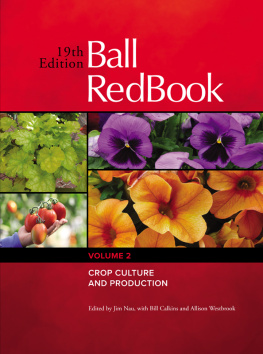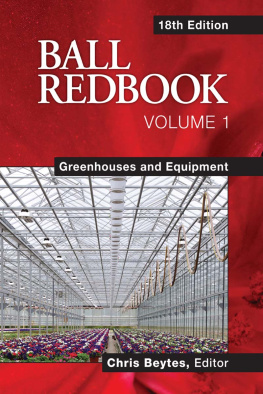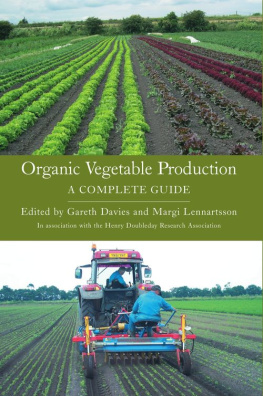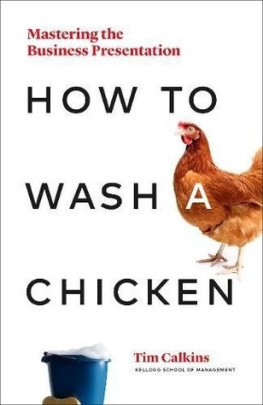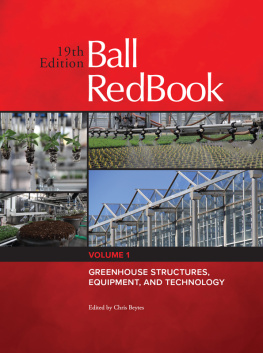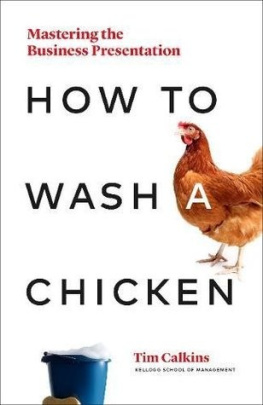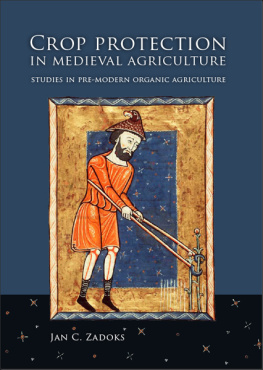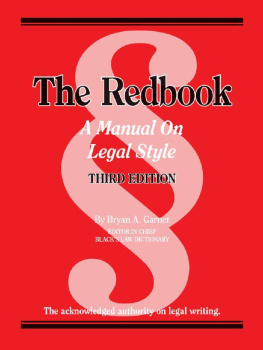BILL CALKINS - BALL REDBOOK crop production.
Here you can read online BILL CALKINS - BALL REDBOOK crop production. full text of the book (entire story) in english for free. Download pdf and epub, get meaning, cover and reviews about this ebook. City: Place of publication not identified, year: 2020, publisher: GEORGE J BALL PUB, genre: Home and family. Description of the work, (preface) as well as reviews are available. Best literature library LitArk.com created for fans of good reading and offers a wide selection of genres:
Romance novel
Science fiction
Adventure
Detective
Science
History
Home and family
Prose
Art
Politics
Computer
Non-fiction
Religion
Business
Children
Humor
Choose a favorite category and find really read worthwhile books. Enjoy immersion in the world of imagination, feel the emotions of the characters or learn something new for yourself, make an fascinating discovery.
- Book:BALL REDBOOK crop production.
- Author:
- Publisher:GEORGE J BALL PUB
- Genre:
- Year:2020
- City:Place of publication not identified
- Rating:3 / 5
- Favourites:Add to favourites
- Your mark:
- 60
- 1
- 2
- 3
- 4
- 5
BALL REDBOOK crop production.: summary, description and annotation
We offer to read an annotation, description, summary or preface (depends on what the author of the book "BALL REDBOOK crop production." wrote himself). If you haven't found the necessary information about the book — write in the comments, we will try to find it.
BALL REDBOOK crop production. — read online for free the complete book (whole text) full work
Below is the text of the book, divided by pages. System saving the place of the last page read, allows you to conveniently read the book "BALL REDBOOK crop production." online for free, without having to search again every time where you left off. Put a bookmark, and you can go to the page where you finished reading at any time.
Font size:
Interval:
Bookmark:

Ball Publishing
622 Town Road
West Chicago, Illinois 60185
www.ballpublishing.com
Copyright 2021 Ball Horticultural Company. All rights reserved.
Unless otherwise noted, all photographs copyright Ball Horticultural Company.
All rights reserved.
Cover designed by Christine Truesdale.
Interior designed by Jennifer Dominiak and Jennifer Ramazinski Miller.
Edited by Rick Blanchette.
Printed by Sheridan Books.
No part of this book may be reproduced or transmitted in any form or by any means, electronic or mechanical, including photocopying, recording, or any information storage-and-retrieval system, without permission in writing from the publisher.
Disclaimer of liabilities: Reference in the publication to a trademark, proprietary product, or company name is intended for explicit description only and does not imply approval or recommendation to the exclusion of others that may be suitable.
While every effort has been made to ensure the accuracy and effectiveness of the information in this book, Ball Publishing makes no guarantee, express or implied, as to the procedures contained herein. Neither the authors nor the publisher will be liable for direct, indirect, incidental, or consequential damages in connection with or arising from the furnishing, performance, or use of this book.
ISBN: 978-1-7332541-2-0 (hardcover)
ISBN: 978-1-7332541-5-1 (ebook)
Library of Congress Cataloging-in-Publication Data
Names: Nau, Jim, 1958- editor. | Calkins, Bill (Book editor), editor. | Westbrook, Allison, editor
Title: Ball redbook. Volume 2, Crop culture and production / edited by Jim Nau, with Bill Calkins and Allison Westbrook.
Description: 19th edition. | West Chicago, Illinois : Ball Publishing, 2021. | Includes bibliographical references and index. | Contents: Volume 2: 1. Water Quality -- 2. Substrates -- 3. Mineral Nutrition -- 4. Managing pH for Root Substrates -- 5. Water, Media, and Nutrition Testing -- 6. Temperature -- 7. Light -- 8. Plant Growth Regulators -- 9. Management of Insect and Mite Pests -- 10. Recognizing and Managing Plant Diseases -- 11. Controlling Soilborne Pests -- 12. Resistance Management -- 13. Propagating Seed Crops -- 14. Propagating Vegetative Crops -- 15. Indexing for Disease -- 16. Postharvest Care and Handling of Potted Plants. | Summary: Celebrating its continuous publication since 1932, the 19th Edition of the Ball RedBook continues to lead the way in floriculture education, with updated and expanded content on the hottest and most profitable commercial greenhouse crops and production ideas, including detailed sections on the production of tropical plants and hemp/cannabis. Volume 2: Crop Culture and Production provides the most up-to-date and helpful growing techniques and cultural details required by professional growers. Written and edited by seasoned green industry professionals and leading academics, Crop Culture and Production presents the information in a clear, concise manner. This isnt theory-its what is working today in real-world greenhouses. In Part 1 of this volume, youll find chapters devoted to water, media, nutrition, pH, temperature, light, growth regulation, propagation, disease indexing, and postharvest care. Part 2 provides cultural details for more than 215 flower, herb, and vegetable crops (a 33% increase over the previous edition!) including an in-depth section on hemp and cannabis production. Each crop includes details about propagation, growing on, insect and disease control, troubleshooting, varieties, and postharvest care-- Provided by publisher.
Identifiers: LCCN 2021010873 | ISBN 9781733254113 (v. 1 ; hardcover) | ISBN 9781733254120 (v. 2 ; hardcover)
Subjects: LCSH: Floriculture. | Plants, Ornamental.
Classification: LCC SB405 .B254 2021a | DDC 635.9--dc23
LC record available at https://lccn.loc.gov/2021010873
Printed in the United States of America
29 28 27 26 25 24 23 22 21 1 2 3 4 5 6 7 8
DEDICATION
The nineteenth edition of the Ball RedBook is dedicated to four generations of the Ball family, starting with George J. Ball, who created the Ball RedBook in 1932; his son Vic, who carried on the tradition until his passing in 1997; Georges granddaughter, Anna, who has ensured that Ball Publishing continues Georges tradition of providing the newest and best cultural and technical information to the horticulture industry; and Annas daughter, Susannah, whom we are certain will keep the tradition alive for the foreseeable future. George once wrote, Our books and trade papers are the most powerful source of information and exchange of ideas that we have. We have expanded that to include e-newsletters, videos, webinars, and podcasts, all of which, we trust, carry on the spirit of the Ball familys desire to help all growers produce better crops.



CONTENTS
PREFACE
We have written this before in preceding editions, but it remains true, so well say it again: Most growers worldwide would agree that if they could only have one book on their greenhouse or nursery office shelf, it would be the Ball RedBook.
The first edition of the Ball RedBook, published in 1932, sold for twenty cents, and was titled Ball Red Book, Miscellaneous Flower Seed Crops. George J. Ball penned the manuscript in longhand. At that time, almost all growers produced cut flowers, and most were also florists. That first edition featured cutting-edge crop culture on cut flowers such as asters (callistephus), stock (matthiola), snapdragons (antirrhinum), larkspur (consolida), sweet peas (lathyrus), mignonette (Reseda odorata), zinnias, centaurea, gerbera, didiscus, and scabiosa. The only bedding plants were petunias, candytuft (iberis), marigolds (tagetes), and lupine.
In todays floriculture industry, most of the commodity cut flower production (roses, chrysanthemums, and carnations) has moved offshore to Colombia, Ecuador, and Africa, and most greenhouse producers focus instead on producing high-value, quick-turning bedding plants, perennials, foliage, and flowering potted plants. There are niche growers producing cut flowers, and many of the crops written about in the first Ball RedBook are profitable specialty cut flowers today. The demand for locally grown fresh vegetables and herbs is creating a new market for greenhouse growers, as is the expanding legalization of cannabis. And not everyone grows in a greenhouse, as our new section on Vertical Farming indicates.
As the industry has changed over the decades, so has the Ball RedBook. Vic Ball took over the editing duties from his father from the eight edition in 1952 to the sixteenth edition in 1998, which was published just after his passing in 1997. Vic improved and expanded the book with each subsequent edition to accommodate an ever-growing list of crops.
But to grow crops you need a greenhouse and tools, and the Ball RedBook also has always covered the technology side of the industry, with Vic sharing the contents of his notebooks filled with comments from growers all over North America and Europe on new ideas such as hydroponics, Dutch trays, roll-out bedding plants, open-roof greenhouses, automatic transplanters, and more. His passion for encouraging innovation among growers and sharing information about growers was boundless.
Font size:
Interval:
Bookmark:
Similar books «BALL REDBOOK crop production.»
Look at similar books to BALL REDBOOK crop production.. We have selected literature similar in name and meaning in the hope of providing readers with more options to find new, interesting, not yet read works.
Discussion, reviews of the book BALL REDBOOK crop production. and just readers' own opinions. Leave your comments, write what you think about the work, its meaning or the main characters. Specify what exactly you liked and what you didn't like, and why you think so.

